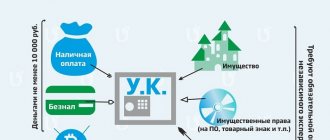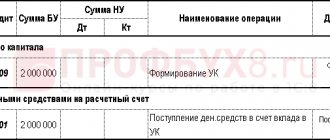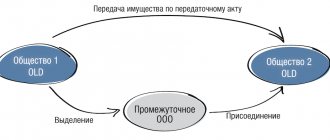Authorized capital is the assets of the organization, which the founders of the LLC contribute after state registration. Since September 2014, the minimum amount of the capital in the amount of 10,000 rubles must be paid in money (Article 66.2 of the Civil Code of the Russian Federation). In excess of this amount, the contribution of the authorized capital is possible both in cash and in property form. The founders can fulfill their obligations to contribute the capital in cash to the organization’s cash desk or deposit the authorized capital into the current account.
Contribution of the authorized capital in cash to the cash register of an LLC requires the execution of cash documents and compliance with the cash limit. If the execution of cash transactions is carried out in violation of the Instructions of the Central Bank, the organization may be fined in the amount of 40 to 50 thousand rubles.
Amount of authorized capital
The minimum amount of capital is established by the Civil Code and laws on business companies:
- for LLC - 10,000 rubles (Clause 1, Article 14 of Federal Law No. 14-FZ);
- for organizers of gambling through bookmakers or sweepstakes - 600 million rubles (Clause 9, Article 6 of Federal Law No. 244-FZ);
- for banks and credit organizations - from 90 million to 1 billion rubles (Article 11 of Federal Law No. 395-1).
The LLC must maintain the minimum amount of authorized capital throughout its activities. If the amount of net assets turns out to be less than the authorized capital for more than 2 tax periods, the company must either reduce the authorized capital, and if this is not possible, then make a decision on liquidation.
Depositing funds to LLC occurs in compliance with the following rules:
- 10,000 rubles are deposited in cash;
- anything over the minimum size can be entered as property;
- property must have an assessment if the nominal share of the property contribution exceeds 20,000 rubles;
- The deadline for making contributions by the founders is no later than 4 months from the date of state registration.
When is paying for a share in an LLC through a cash register impossible or illegal?
Obstacles to depositing a share through the cash register may arise if the company makes all payments by bank transfer - the deposit will have to be paid to the current account.
In some cases, making a contribution to the authorized capital (including through a cash desk) may be considered illegal, for example:
- money is contributed by a non-resident founder (violation of currency legislation);
- the monetary statutory contribution was received by the cash desk from a person who does not have the right to act as a founder of the company (violation of the Civil Code and other laws);
- in other cases (for example, a contribution to the authorized capital of an insurance company was made to the cash desk with borrowed funds, which is a violation of paragraph 3 of Article 25 of the Law “On Insurance Business in the Russian Federation” dated November 27, 1992 No. 4015-1).
Let's take a closer look at the first two situations.
The money was contributed by the non-resident founder
If your founder is a foreign legal entity, accepting a cash contribution from him to the cash desk will be a violation of subclause. 9 "b" clause 1 art. 1 of the Law “On Currency Regulation” dated December 10, 2003 No. 173-FZ.
Depositing money into the authorized capital in this case (even if it happens in rubles) is a currency transaction, and it cannot be carried out through a cash desk. According to clause 2 of Law No. 173-FZ, payments for such operations are made through bank accounts in authorized banks (the procedure for opening and maintaining them is established by the Central Bank).
Find out how currency regulation is organized in our country here.
For accepting funds from such a founder into the cash register, you may be punished financially under clause 1 of Art. 15.25 of the Code of Administrative Offenses of the Russian Federation (from 3/4 to 1 of the amount of the illegal transaction).
The founder who contributed the money cannot be a participant in the LLC
Before accepting money from an LLC participant as a contribution to the authorized capital, check whether the participant’s stay in this status is legal.
The legislation establishes that:
- foreign firms, domestic companies with foreign participation in the authorized capital of 50% or more, citizens of the Russian Federation with dual citizenship are prohibited from acting as founders of radio and television channels, television, radio and video programs (Article 19.1 of the Law “On the Media” dated December 27, 1991 No. 2124-1);
- an LLC consisting of one participant cannot be the sole founder or participant of another LLC (Clause 2, Article 7 of Law No. 14-FZ);
- Persons in military service cannot act as founders - clause 7 of Art. 10 of the law on the status of military personnel of May 27, 1998 No. 76-FZ, other citizens (civil servants, etc.)
This publication will tell you when and in what order they are removed from the military register.
Formation of authorized capital: postings
Each founder contributes his share within the period established in the decision upon establishment, but no later than 4 months from the date of registration of the LLC. If there is more than one founder, the accounting records reflect the debt of each of them in the amount of his share.
Example
The co-founders of the LLC with a declared capital of 60,000 rubles are three individuals. The shares of participants are distributed as follows: 50% of the capital belongs to individual 1, 20% to individual No. 2 and 30% to individual No. 3.
In accounting, the entries for the formation of the management company are as follows:
- Dt 75.01 “Individual No. 1” Kt 80 in the amount of 30,000 rubles;
- Dt 75.01 “Individual No. 2” Kt 80 in the amount of 12,000 rubles;
- Dt 75.01 “Individual No. 2” Kt 80 in the amount of 18,000 rubles.
Thus, on the credit of account 80 the full value of the share capital will be formed in the amount of 60,000 rubles, and on the debit of account 75.01 the debt of each of the founders will be reflected.
The date of the postings must be the next day after the date of registration of the LLC, the content of the postings is as follows: “The debt of the founder has been accrued in the amount of his share.”
BASIC: income tax
Contributions of founders to the authorized capital in cash or in kind are not recognized as income of the organization (subclause 3, clause 1, article 251, subclause 1, clause 1, article 277 of the Tax Code of the Russian Federation). This procedure also applies to situations where the founders’ monetary claims to the company are offset against payment of the authorized capital (letter of the Ministry of Finance of Russia dated August 1, 2011 No. 03-03-06/1/439).
At the same time, the cost of property contributed to the authorized capital can be written off as expenses. To do this, the property contribution must be assessed, and the organization itself must use the property in commercial activities.
The procedure for determining the value of a property contribution depends on who made the contribution: a citizen, a Russian organization or a foreign organization.
If the contribution is made by a citizen or a foreign organization, the following rules must be followed. The value of the property contribution is equal to the amount of documented expenses for the acquisition of property transferred to the authorized capital. Documents that confirm the founder’s expenses can be receipts for cash receipt orders, sales receipts, cash receipts, etc. In addition, an independent specialist must give his assessment of the property contribution. When calculating income tax, an organization will be able to include the lesser of these amounts in expenses. If the value of the property contribution is not documented, then in tax accounting it will have to be recognized as zero.
The contribution of the Russian organization is assessed according to the following rules. Its value in tax accounting will be equal to the residual value of the object in the tax accounting of the transferring party. The residual value of the property can be confirmed by extracts (copies) from tax registers. If the transferring party cannot confirm the residual value of the transferred property, then in tax accounting accept such property with zero initial cost.
The transferring party's expenses associated with the transfer of property increase the initial cost of the fixed asset only if they are indicated as a contribution to the authorized capital in the constituent documents.
This follows from the rules provided for in subparagraph 2 of paragraph 1 of Article 277 of the Tax Code of the Russian Federation.
Fixed assets or intangible assets received from the founders with a value exceeding 100,000 rubles. needs to be depreciated (clause 1 of article 256 of the Tax Code of the Russian Federation).
Fixed assets worth 100,000 rubles. and less be taken into account as part of material costs as they are put into operation (subclause 3, clause 1, article 254 of the Tax Code of the Russian Federation). On accounting for intangible assets worth 100,000 rubles. and less, see in more detail Which property is considered depreciable in tax accounting.
Write off the cost of materials contributed to the authorized capital as expenses as they are released into production or operation (clause 2 of Article 272, subclause 1 of clause 3 of Article 273, subclause 3 of clause 1 of Article 254 of the Tax Code of the Russian Federation). When goods intended for resale are received, their cost is included in post-sale expenses (Clause 1, Article 268 of the Tax Code of the Russian Federation).
An example of how to take into account the value of property contributed by the founder to the authorized capital of the company. The organization applies a general taxation system
In February, one of the founders of Proizvodstvennaya LLC A.V. Lvov contributed 5 tons of profile pipes to the authorized capital of the organization.
The purchase price of materials is 50,000 rubles, which is confirmed by sales and cash receipts. The same cost is agreed upon by the founders. And according to an independent expert, the market value of the transferred materials is 60,000 rubles.
In March, all 5 tons of pipes were released into production and consumed.
The organization's accountant made the following entries in the accounting.
In February:
Debit 10 Credit 75-1 – 50,000 rub. – pipes were received as a contribution to the authorized capital.
In March:
Debit 20 Credit 10 – 50,000 rub. – pipes were released into production.
Documented costs for the purchase of pipes are less than their value established by the appraiser. Therefore, for tax purposes, contributed materials are accepted at a purchase price of 50,000 rubles.
When calculating income tax for March, Master's accountant attributed this amount to material expenses.
Situation: how to determine in tax accounting the initial cost of property received by an OJSC as a contribution to the authorized capital during the privatization process from the municipal property management committee?
The answer to this question depends on the composition of the participants of the joint-stock company.
Privatization of state (municipal) property means its alienation for a fee into the ownership of citizens and (or) organizations (Clause 1, Article 2 of Law No. 178-FZ of December 21, 2001). One of the forms of privatization of state (municipal) property is its transfer as a contribution to the authorized capital of open joint-stock companies (subparagraph 9, paragraph 1, article 13 of the Law of December 21, 2001 No. 178-FZ).
The Tax Code of the Russian Federation establishes a special procedure for determining the value of property that an organization receives as a contribution to the authorized capital in the process of privatization of state (municipal) property. For profit tax purposes, such property is accepted at cost (depreciable property - at residual value), determined according to the accounting rules as of the date of privatization (paragraph 5, subparagraph 2, clause 1, article 277 of the Tax Code of the Russian Federation).
In accounting, the initial value of fixed assets and securities received as a contribution to the authorized capital is recognized as their monetary value, agreed upon by the founders (clause 9 of PBU 6/01, clause 12 of PBU 19/02). Thus, if the property management committee is not the only founder of a joint-stock company, the initial value of the property received as a contribution to the authorized capital will be its monetary value, agreed upon with the other founders. If the property management committee is the sole founder of the company (i.e., the municipality’s share in the authorized capital is 100%), the initial value of the property received as a contribution to the authorized capital will be reflected in the transfer and acceptance certificate:
- the cost of the property;
- price of securities.
Similar clarifications are contained in letters of the Ministry of Finance of Russia dated March 15, 2012 No. 03-03-06/1/129, dated June 17, 2009 No. 03-03-06/1/403.
In the situation under consideration, the company that receives the property as a contribution to the authorized capital does not need to determine the market value of the transferred property with the involvement of an independent appraiser.
When selling a fixed asset received as a contribution to the authorized capital, the organization has the right to reduce the proceeds from the sale by its residual value (clause 1 of Article 268 of the Tax Code of the Russian Federation). For more information about this, see How to take into account income and expenses from the sale of depreciable property for income tax purposes.
When selling securities, the tax base for income tax is determined as the difference between the income received from their sale and the expenses that the organization incurred in connection with this operation (clause 2 of Article 280 of the Tax Code of the Russian Federation). At the same time, the costs reflect the purchase price of shares (including the costs of their acquisition), as well as the costs of their sale (clause 2 of Article 280 of the Tax Code of the Russian Federation). Shares received as a contribution to the authorized capital do not have an acquisition price. Therefore, when selling, it will be possible to include in expenses the cost of shares formed in accordance with the norms of paragraph 5 of subparagraph 2 of paragraph 1 of Article 277 of the Tax Code of the Russian Federation, as well as expenses associated with their sale. Similar explanations are contained in the letter of the Ministry of Finance of Russia dated June 1, 2006 No. 03-03-04/1/498.
Situation: does a difference arise when converting the value of shares from hryvnia to rubles? The organization, located in the Republic of Crimea (Sevastopol), brings the charter of the joint-stock company into compliance with the legislation of the Russian Federation.
The difference can only arise if the value of the shares is recalculated at a rate different from the one at which the accounting figures were converted into rubles.
Let me explain. From June 1, 2014, organizations located in Crimea (Sevastopol) must keep accounting records in rubles. It was on this date that all accounting objects had to be converted from hryvnia to rubles at the official rate. If the majority of transactions in rubles occurred before June 1, 2014, then you can recalculate using an earlier date.
In addition, joint stock companies must bring their charter into compliance with Russian legislation. In particular, there is an obligation to convert shares whose value is expressed in hryvnias into shares with a ruble par value. In this case, the conversion rate for the value of shares is taken on one of the following dates:
- on the date of the general meeting of shareholders;
- on another date established by the decision of the general meeting of shareholders.
This is provided for in paragraph 8 of Bank of Russia Order No. OD-1983 dated August 1, 2014.
Thus, when recalculating the value of shares, three options are possible.
Option 1. The conversion rate for shares is determined on the same date as the accounting indicators
In the decision of the general meeting of shareholders, the organization has the right to indicate that the par value of shares is determined in rubles at the exchange rate on the date of recalculation of accounting indicators. If so, then there will be no difference.
Option 2. The conversion rate of shares was determined on a date different from the day of recalculation of accounting indicators, and it decreased
If the exchange rate has decreased, then the total par value of the shares has become less than the authorized capital. The one that turned out when recalculating accounting indicators. Reflect such an operation as a decrease in the authorized capital due to a decrease in the par value of the shares in both accounting and tax accounting.
Option 3. The conversion rate of shares was determined on a date different from the day of recalculation of accounting indicators, and it increased
If the rate has increased, then the total par value of the shares has increased. And this led to an increase in the authorized capital. For information on how to reflect such a result in accounting, see How to reflect in accounting an increase in the authorized capital of a joint-stock company due to conversion.
Contribution to the authorized capital: postings
Within 4 months from the date of registration of the Company, the founders must contribute their shares. 10,000 can be deposited only in money, and amounts exceeding the minimum amount of the authorized capital can be deposited with property. Funds are deposited into the cash desk or into the organization's current account, if it is already open.
Contribution of authorized capital to the cash desk, postings: Dt 50 Kt 75.01.
Contribution to the current account: Dt 51 Kt 75.01 - when transferred from an individual’s current account or when deposited through a bank branch.
Property contribution: Dt 01 (04, 10, 41, 58, 66, 76, 97) Kt 75.01 for the amount of property valuation.
When creating the entry “contribution to the authorized capital through the cash register,” you should take into account the cash limit and funds exceeding the limit that can be deposited into the LLC’s current account.
In the process of economic activity, the amount of the capital may change up or down by the decision of the founders.
Basic principles for entering the Criminal Code
The authorized capital is the first asset of the company, contributed by its founders already in the process of registering the LLC with the state. organs Article 66.2 of the Civil Code sets the lower limit for the size of the authorized capital at 10 thousand rubles. exclusively in cash. If you wish, you can contribute more, including property. For certain areas of activity, the Criminal Code must be higher than the general minimum. Namely, for such types as the production of excisable goods, credit and banking, and some types of insurance.
In any case, the money can be cash or non-cash. They can be deposited either into the company’s cash desk or into its bank account. Please note that when depositing the authorized capital into the company's cash desk in cash, it is necessary to correctly document the transaction and take into account the cash register limit. Violations of the relevant requirements of the Central Bank of the Russian Federation in the execution of such procedures are punishable by fines in the range of 40,000–50,000 rubles.
Increase in capital
An increase in the amount of share capital can be made both by the decision of the founders and by legal requirements.
The company considers the issue and makes a decision to increase capital in the following cases:
- lack of working capital;
- accepting new participants;
- additional issue of shares (for joint-stock companies, joint-stock companies);
- acquisition of licenses for activities that require a larger capital amount.
The source of increase in share capital will be either the LLC’s own property, or contributions from new founders, or additional contributions from existing members of the company.
Increase in authorized capital, posting:
| Due to net profit | Dt 84 Kt 80 |
| Due to the contributions of new LLC participants | Dt 75.01 Kt 80 |
| By increasing the contributions of existing participants of the Company | Dt 75.01 Kt 80 |
A new participant in an LLC: what to do before and after paying the share?
The emergence of a new founder in an LLC can occur either with an increase in the authorized capital or without it (if a new participant in the company acquires the share of the retired founder).
Let's consider the scheme of the emergence of a new participant, accompanied by an increase in the authorized capital (hereinafter also referred to as the authorized capital).
In this situation, before the new participant pays for the share, it will be necessary (Articles 17–19 of Law No. 14-FZ):
- check whether all current participants have paid for their shares - if not, an increase in the authorized capital is not allowed;
- make sure that the company’s charter does not prohibit increasing the capital capital at the expense of contributions from third parties;
- receive an application from a new participant with a request to accept him into the company (indicating the amount of the contribution, the timing and procedure for payment);
- convene a meeting of participants to resolve issues of introducing a new participant into the founders, increasing the capital and other related issues on the agenda;
- draw up the minutes (decision) of the general meeting, which must reflect:
- the fact of accepting a new participant into the LLC and increasing the capital due to his contribution;
- the size and nominal share of the new participant, adjustment of the shares of the remaining founders;
- approval of a new version of the LLC charter in connection with an increase in the authorized capital.
A new participant can contribute money or property.
Find out how to reflect in accounting the contribution of authorized capital to the cash desk of an enterprise in ConsultantPlus. To do everything correctly, get trial access to the system and go to the Ready solution. It's free.
Decrease in capital
A change in the size of the capital company downward is made either by decision of the owners or as required by law. In both cases, this operation is formalized by a decision of the general meeting of founders with the subsequent submission of documents to the registration authority.
The law requires a reduction in the size of the capital in the event of:
- late payment by the founders;
- if the value of net assets is lower than the authorized capital, that is, in case of unprofitable activities.
If part of the capital is not paid on time, accounting entry Dt 80 Kt 81 “Own shares (shares)” arises for part of the unpaid contribution of the founders. The posting date is the next day after the expiration of the 4-month period from the date of registration of the LLC.
In case of unprofitable activities, part of the capital is directed to repay the loss: Dt 80 Kt 84 “Retained earnings”. The posting date corresponds to the date of the decision to reduce capital to the amount of net assets.
The owners decide to reduce the size of the management company:
- upon withdrawal of a participant from the LLC and payment of his share of participation - Dt 80 Kt 75 “Calculations for contributions to the authorized capital”;
- when the Company redeems part of the capital shares into ownership - Dt 81 “Own shares (shares)” Kt 75.01 “Settlements on contributions to the authorized capital” - with subsequent cancellation of the purchased shares - Dt 80 Kt 81 “Own shares (shares)”;
- with a proportional decrease in the share of participants or the par value of shares. The resulting difference may become the Company’s income - Dt 80 Kt 91.01 “Other income” or paid to participants - Dt 80 Kt 75.01 “Settlements on contributions to the authorized capital”.
The posting dates for capital reductions correspond to the date the registration changes are recorded.
Rules for entering the management capital of an LLC
The rules for contributing the authorized capital are regulated by Chapter. 3 of Law No. 14-FZ “On LLC” (link at the end of the article). According to it, when contributing a share of the management company in the form of property, its value must be determined by an independent expert. If you value the time or money that you will have to pay for the services of an appraiser, you can limit yourself to contributing cash capital.
The legislator reserves the right of the founders to decide on opening a current account. But, since sooner or later you will still need it, it is better to deal with this issue early.
There is no need to inform either tax or any other authorities about the contribution of the authorized capital. This information must be reflected in the annual reports. And it, in turn, must reach the recipients within the appropriate time frame.
Payment terms for management company
The authorized capital must be paid before the expiration of 4 months after the company is entered into the Unified State Register of Legal Entities. Until this point, the legislator does not oblige to pay any part of the capital. The deadlines are set by the founders themselves. It is only prohibited to exempt anyone from paying his share of the capital or to postpone the payment deadline specified in the memorandum of association.
The founder’s share, which is paid late or not in full, may be transferred to the organization and distributed among the remaining founders. Also, the memorandum of association can provide for fines and penalties for such non-compliance.
Methods for entering the capital
The law allows such methods of contributing authorized capital as:
- non-cash;
- spot;
- in property form;
- securities;
- intellectual property.
In non-cash form, the amount transferred to the account must be marked “Founder’s contribution to the authorized capital.” The account may be temporary, opened prior to the registration of the LLC specifically for the purpose of depositing the authorized capital. In this case, it is then replaced with a permanent one. A certificate from the bank about the transaction performed is a supporting document. These funds can be immediately used for the purposes of the organization.
Each founder himself contributes his share of the capital in accordance with the terms determined by the founding agreement.
Authorized capital is allowed to be deposited in cash both to a bank account and directly to the organization’s cash desk. In the second option, a cash receipt order is issued, which is then stored in the accounting documentation. The receipt for the founder who contributed the money is signed by the accountant and the cashier (if there is one).
The property contribution to the management company is formalized by an act of placing the property on the balance sheet of the organization. In the event of an unreasonable overestimation of its value, both the appraiser and the founder who contributed the property will be punished.
Accounting entries when depositing capital into a current account
The formation of the authorized capital is reflected in accounting entries. For this reason, it is better to organize accounting from the beginning of society. Postings for the transfer of funds from the management company to the organization’s account are carried out as follows.
- The formation of the management company is reflected in account 80 “authorized capital”.
- Contribution of the share of the founders - on account 75 “Settlements with founders”, subaccount 75.1 “Settlements on contributions to the authorized capital”. Posting: Debit 75.1 - Credit 80.
- Depositing the capital into the account: Debit 51, Credit - 75.1.
In conclusion, let us remind you that the size of the authorized capital is not a fixed amount once and for all. It can increase or decrease at any time and for any reason that is significant to the founders. The company has the right to use the funds of the management company:
- to pay salaries to employees;
- to pay for the rent of office and industrial premises;
- for the purchase of goods or equipment.
The main thing is that these and other costs do not reduce the amount of authorized capital below the above minimum. Moreover, the latter is only 10 thousand rubles.
Sources:
Civil Code of the Russian Federation Article 66.2. Basic provisions on the authorized capital of a business company
Law No. 14-FZ “On LLC”. Chapter III. Authorized capital of the company. Society property
Authorized capital upon liquidation of the company
The procedure for liquidating an LLC is not at all easy and affects many different aspects, primarily financial. What to do with the management company and property? Many questions arise.
Liquidation of a limited liability company is a multi-stage and complex process. It must fully comply with the legislation of the Russian Federation.
As for the capital, it can be divided among the company participants who contributed it, but only after all debts to creditors have been repaid.
Settlement with company participants is part of the entire liquidation procedure.
The management body of the company appoints the composition of the liquidation commission, to which all management functions are transferred. The Federal Tax Service is notified of the planned liquidation, and all creditors are also notified.
Creditors have 2 months to make any claims against the company. There are cases when this period increases, for example, if the company has a lot of debt obligations.
The entire procedure as a whole, until the payment of the authorized capital, can last several months, or maybe several years.
A queue is created according to which all debts of the society are paid off:
- Citizens whose life or health has been harmed due to the fault of society;
- LLC employees;
- Budgetary and extra-budgetary payments;
- Settlements with other groups of persons.
Only after this are debts to the participants repaid in proportion to their shares.
After all calculations, a liquidation balance sheet is drawn up. This is the company's latest reporting. If the company is bankrupt, then all debts are repaid with the help of the management company. This is done by the appointed arbitration manager.
Features of payment of authorized capital in foreign currency
The procedure for contributing foreign currency to the authorized capital is more specific. Russian enterprises do not have the right to make a contribution to the authorized capital in foreign currency, since this is prohibited by Art. 9 of the Federal Law of December 10, 2003 No. 173-FZ “On Currency Regulation and Currency Control” . As for foreign investors, according to Art. 6 of the Federal Law of July 9, 1999 No. 160-FZ “On Foreign Investments in the Russian Federation” they can make a contribution in foreign currency. In this case, the assessment of capital investment is carried out in the currency of the Russian Federation. The resulting exchange rate difference is subject to credit to the enterprise’s additional capital ( clause 14 of PBU 3/2006 ).






